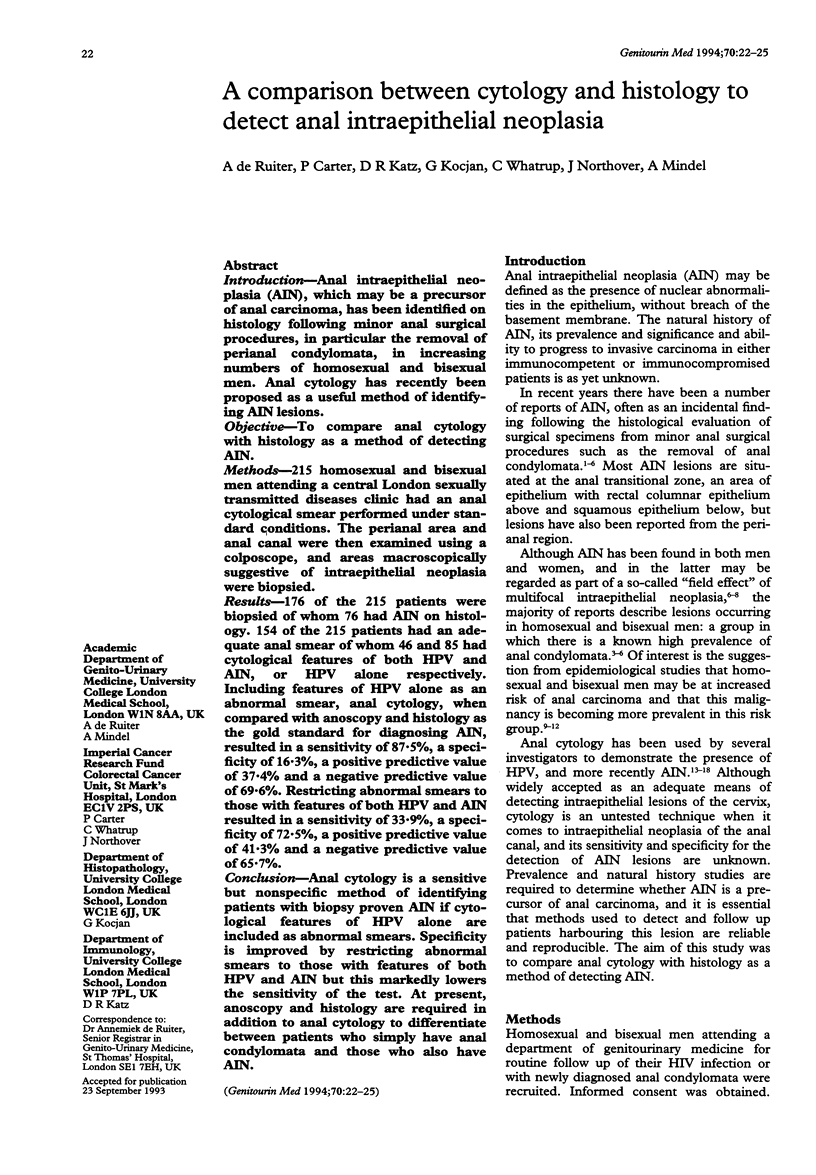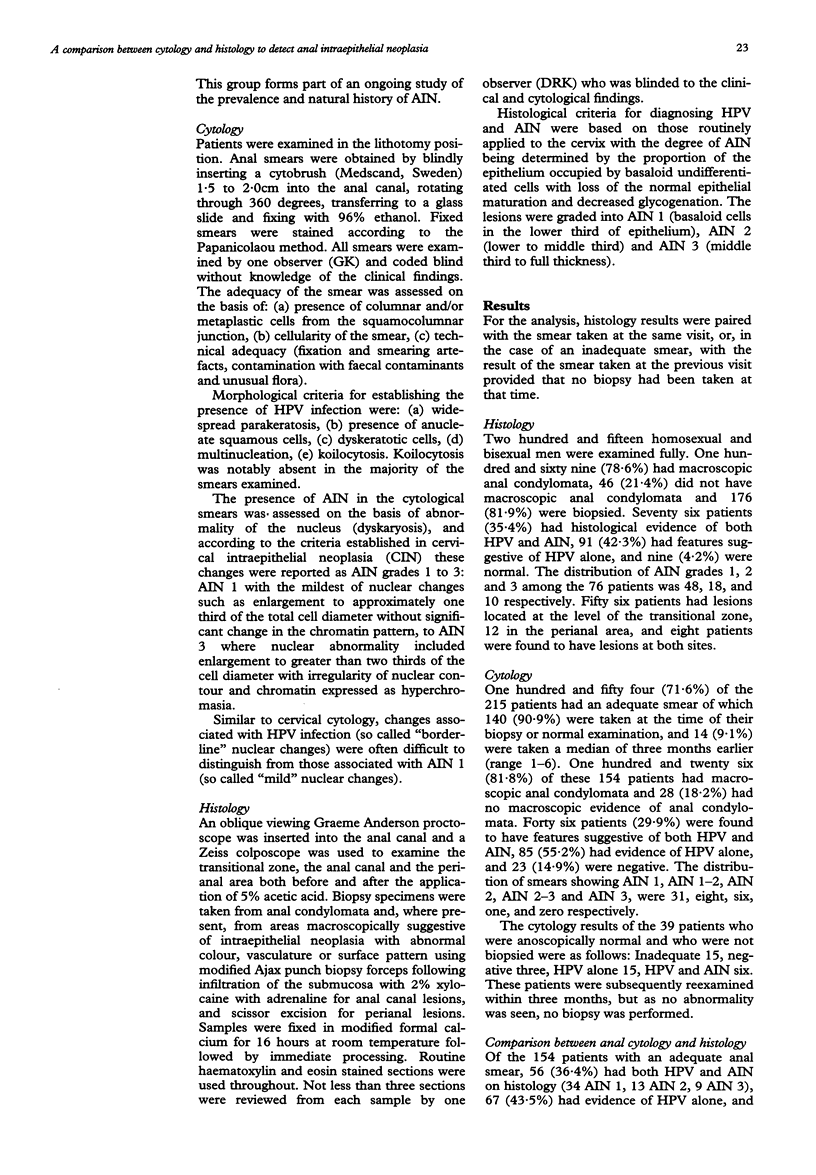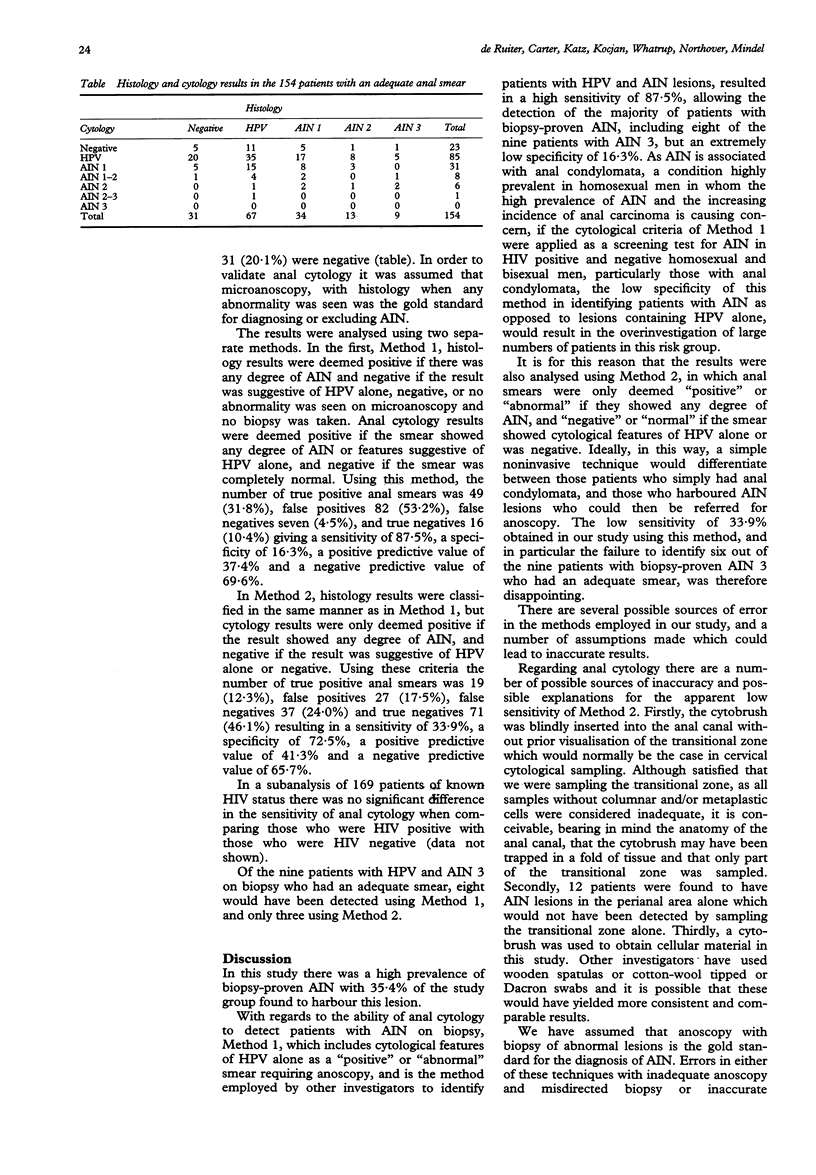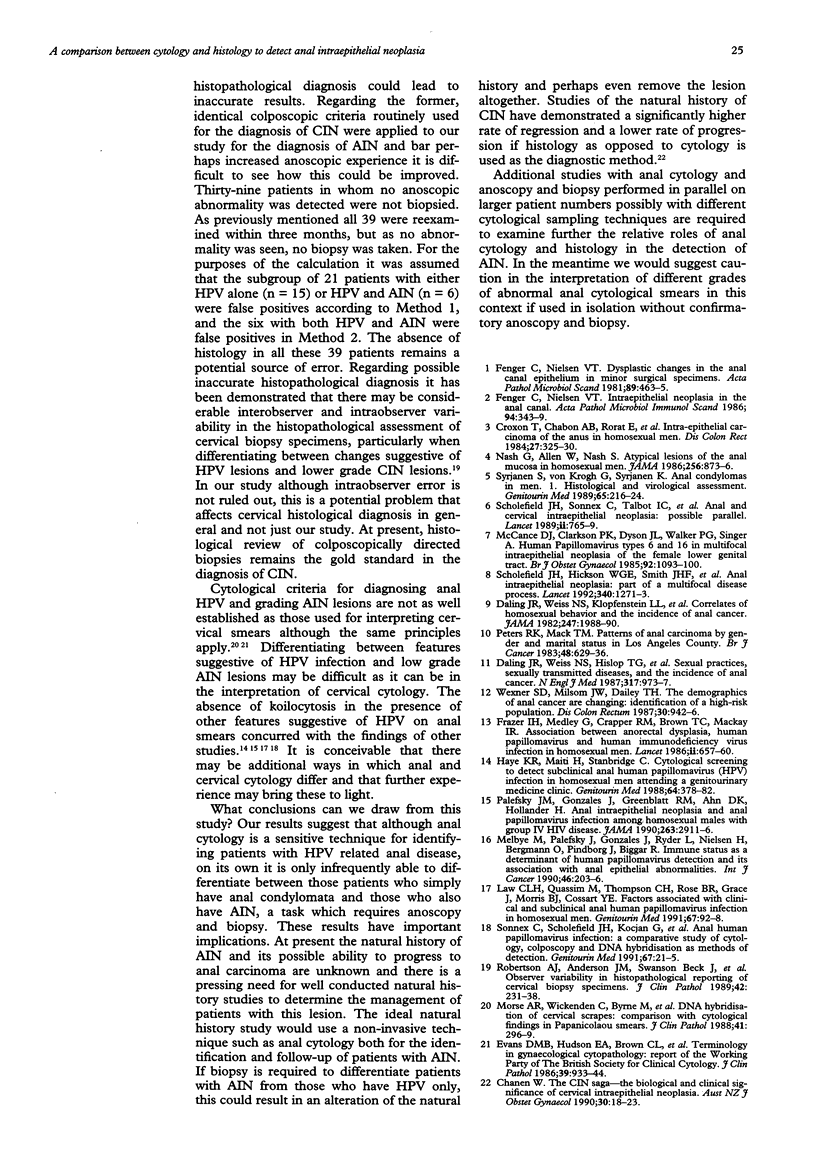Abstract
INTRODUCTION--Anal intraepithelial neoplasia (AIN), which may be a precursor of anal carcinoma, has been identified on histology following minor anal surgical procedures, in particular the removal of perianal condylomata, in increasing numbers of homosexual and bisexual men. Anal cytology has recently been proposed as a useful method of identifying AIN lesions. OBJECTIVE--To compare anal cytology with histology as a method of detecting AIN. METHODS--215 homosexual and bisexual men attending a central London sexually transmitted diseases clinic had an anal cytological smear performed under standard conditions. The perianal area and anal canal were then examined using a colposcope, and areas macroscopically suggestive of intraepithelial neoplasia were biopsied. RESULTS--176 of the 215 patients were biopsied of whom 76 had AIN on histology. 154 of the 215 patients had an adequate anal smear of whom 46 and 85 had cytological features of both HPV and AIN, or HPV alone respectively. Including features of HPV alone as an abnormal smear, anal cytology, when compared with anoscopy and histology as the gold standard for diagnosing AIN, resulted in a sensitivity of 87.5%, a specificity of 16.3%, a positive predictive value of 37.4% and a negative predictive value of 69.6%. Restricting abnormal smears to those with features of both HPV and AIN resulted in a sensitivity of 33.9%, a specificity of 72.5%, a positive predictive value of 41.3% and a negative predictive value of 65.7%. CONCLUSION--Anal cytology is a sensitive but nonspecific method of identifying patients with biopsy proven AIN if cytological features of HPV alone are included as abnormal smears. Specificity is improved by restricting abnormal smears to those with features of both HPV and AIN but this markedly lowers the sensitivity of the test. At present, anoscopy and histology are required in addition to anal cytology to differentiate between patients who simply have anal condylomata and those who also have AIN.
Full text
PDF



Selected References
These references are in PubMed. This may not be the complete list of references from this article.
- Chanen W. The CIN saga--the biological and clinical significance of cervical intraepithelial neoplasia. Aust N Z J Obstet Gynaecol. 1990 Feb;30(1):18–23. doi: 10.1111/j.1479-828x.1990.tb03188.x. [DOI] [PubMed] [Google Scholar]
- Croxson T., Chabon A. B., Rorat E., Barash I. M. Intraepithelial carcinoma of the anus in homosexual men. Dis Colon Rectum. 1984 May;27(5):325–330. doi: 10.1007/BF02555647. [DOI] [PubMed] [Google Scholar]
- Daling J. R., Weiss N. S., Hislop T. G., Maden C., Coates R. J., Sherman K. J., Ashley R. L., Beagrie M., Ryan J. A., Corey L. Sexual practices, sexually transmitted diseases, and the incidence of anal cancer. N Engl J Med. 1987 Oct 15;317(16):973–977. doi: 10.1056/NEJM198710153171601. [DOI] [PubMed] [Google Scholar]
- Daling J. R., Weiss N. S., Klopfenstein L. L., Cochran L. E., Chow W. H., Daifuku R. Correlates of homosexual behavior and the incidence of anal cancer. JAMA. 1982 Apr 9;247(14):1988–1990. [PubMed] [Google Scholar]
- Evans D. M., Hudson E. A., Brown C. L., Boddington M. M., Hughes H. E., Mackenzie E. F., Marshall T. Terminology in gynaecological cytopathology: report of the Working Party of the British Society for Clinical Cytology. J Clin Pathol. 1986 Sep;39(9):933–944. doi: 10.1136/jcp.39.9.933. [DOI] [PMC free article] [PubMed] [Google Scholar]
- Frazer I. H., Medley G., Crapper R. M., Brown T. C., Mackay I. R. Association between anorectal dysplasia, human papillomavirus, and human immunodeficiency virus infection in homosexual men. Lancet. 1986 Sep 20;2(8508):657–660. doi: 10.1016/s0140-6736(86)90168-6. [DOI] [PubMed] [Google Scholar]
- Haye K. R., Maiti H., Stanbridge C. M. Cytological screening to detect subclinical anal human papillomavirus (HPV) infection in homosexual men attending genitourinary medicine clinic. Genitourin Med. 1988 Dec;64(6):378–382. doi: 10.1136/sti.64.6.378. [DOI] [PMC free article] [PubMed] [Google Scholar]
- McCance D. J., Clarkson P. K., Dyson J. L., Walker P. G., Singer A. Human papillomavirus types 6 and 16 in multifocal intraepithelial neoplasias of the female lower genital tract. Br J Obstet Gynaecol. 1985 Nov;92(11):1093–1100. doi: 10.1111/j.1471-0528.1985.tb03018.x. [DOI] [PubMed] [Google Scholar]
- Melbye M., Palefsky J., Gonzales J., Ryder L. P., Nielsen H., Bergmann O., Pindborg J., Biggar R. J. Immune status as a determinant of human papillomavirus detection and its association with anal epithelial abnormalities. Int J Cancer. 1990 Aug 15;46(2):203–206. doi: 10.1002/ijc.2910460210. [DOI] [PubMed] [Google Scholar]
- Morse A. R., Wickenden C., Byrne M., Taylor-Robinson D., Smith J., Anderson M. C., Smith C., Malcolm A. D., Coleman D. V. DNA hybridisation of cervical scrapes: comparison with cytological findings in Papanicolaou smears. J Clin Pathol. 1988 Mar;41(3):296–299. doi: 10.1136/jcp.41.3.296. [DOI] [PMC free article] [PubMed] [Google Scholar]
- Nash G., Allen W., Nash S. Atypical lesions of the anal mucosa in homosexual men. JAMA. 1986 Aug 15;256(7):873–876. [PubMed] [Google Scholar]
- Palefsky J. M., Gonzales J., Greenblatt R. M., Ahn D. K., Hollander H. Anal intraepithelial neoplasia and anal papillomavirus infection among homosexual males with group IV HIV disease. JAMA. 1990 Jun 6;263(21):2911–2916. [PubMed] [Google Scholar]
- Peters R. K., Mack T. M. Patterns of anal carcinoma by gender and marital status in Los Angeles County. Br J Cancer. 1983 Nov;48(5):629–636. doi: 10.1038/bjc.1983.244. [DOI] [PMC free article] [PubMed] [Google Scholar]
- Robertson A. J., Anderson J. M., Beck J. S., Burnett R. A., Howatson S. R., Lee F. D., Lessells A. M., McLaren K. M., Moss S. M., Simpson J. G. Observer variability in histopathological reporting of cervical biopsy specimens. J Clin Pathol. 1989 Mar;42(3):231–238. doi: 10.1136/jcp.42.3.231. [DOI] [PMC free article] [PubMed] [Google Scholar]
- Scholefield J. H., Hickson W. G., Smith J. H., Rogers K., Sharp F. Anal intraepithelial neoplasia: part of a multifocal disease process. Lancet. 1992 Nov 21;340(8830):1271–1273. doi: 10.1016/0140-6736(92)92961-e. [DOI] [PubMed] [Google Scholar]
- Scholefield J. H., Sonnex C., Talbot I. C., Palmer J. G., Whatrup C., Mindel A., Northover J. M. Anal and cervical intraepithelial neoplasia: possible parallel. Lancet. 1989 Sep 30;2(8666):765–769. doi: 10.1016/s0140-6736(89)90830-1. [DOI] [PubMed] [Google Scholar]
- Sonnex C., Scholefield J. H., Kocjan G., Kelly G., Whatrup C., Mindel A., Northover J. M. Anal human papillomavirus infection: a comparative study of cytology, colposcopy and DNA hybridisation as methods of detection. Genitourin Med. 1991 Feb;67(1):21–25. doi: 10.1136/sti.67.1.21. [DOI] [PMC free article] [PubMed] [Google Scholar]
- Syrjänen S. M., von Krogh G., Syrjänen K. J. Anal condylomas in men. 1. Histopathological and virological assessment. Genitourin Med. 1989 Aug;65(4):216–224. doi: 10.1136/sti.65.4.216. [DOI] [PMC free article] [PubMed] [Google Scholar]
- Wexner S. D., Milsom J. W., Dailey T. H. The demographics of anal cancers are changing. Identification of a high-risk population. Dis Colon Rectum. 1987 Dec;30(12):942–946. doi: 10.1007/BF02554281. [DOI] [PubMed] [Google Scholar]


